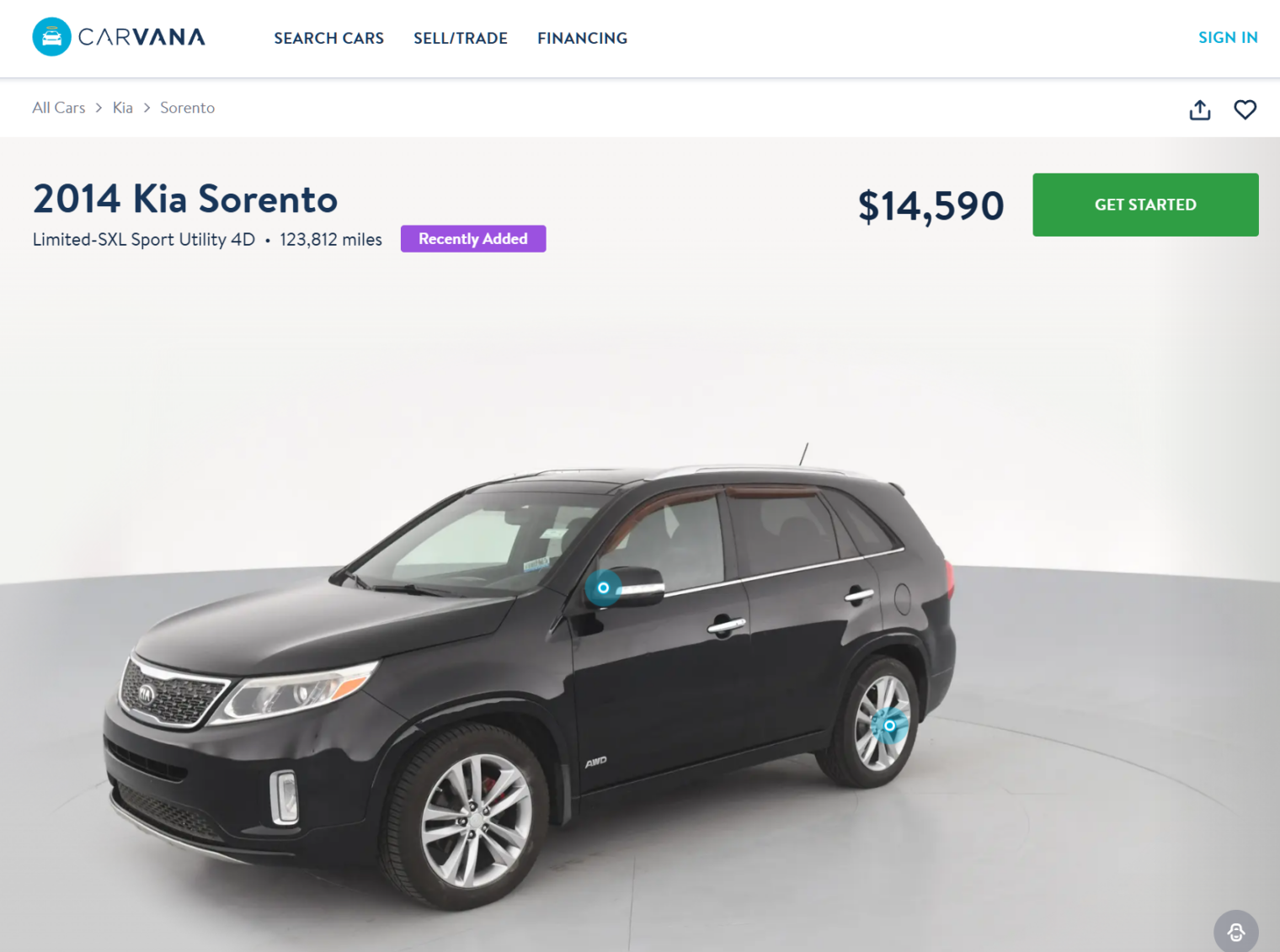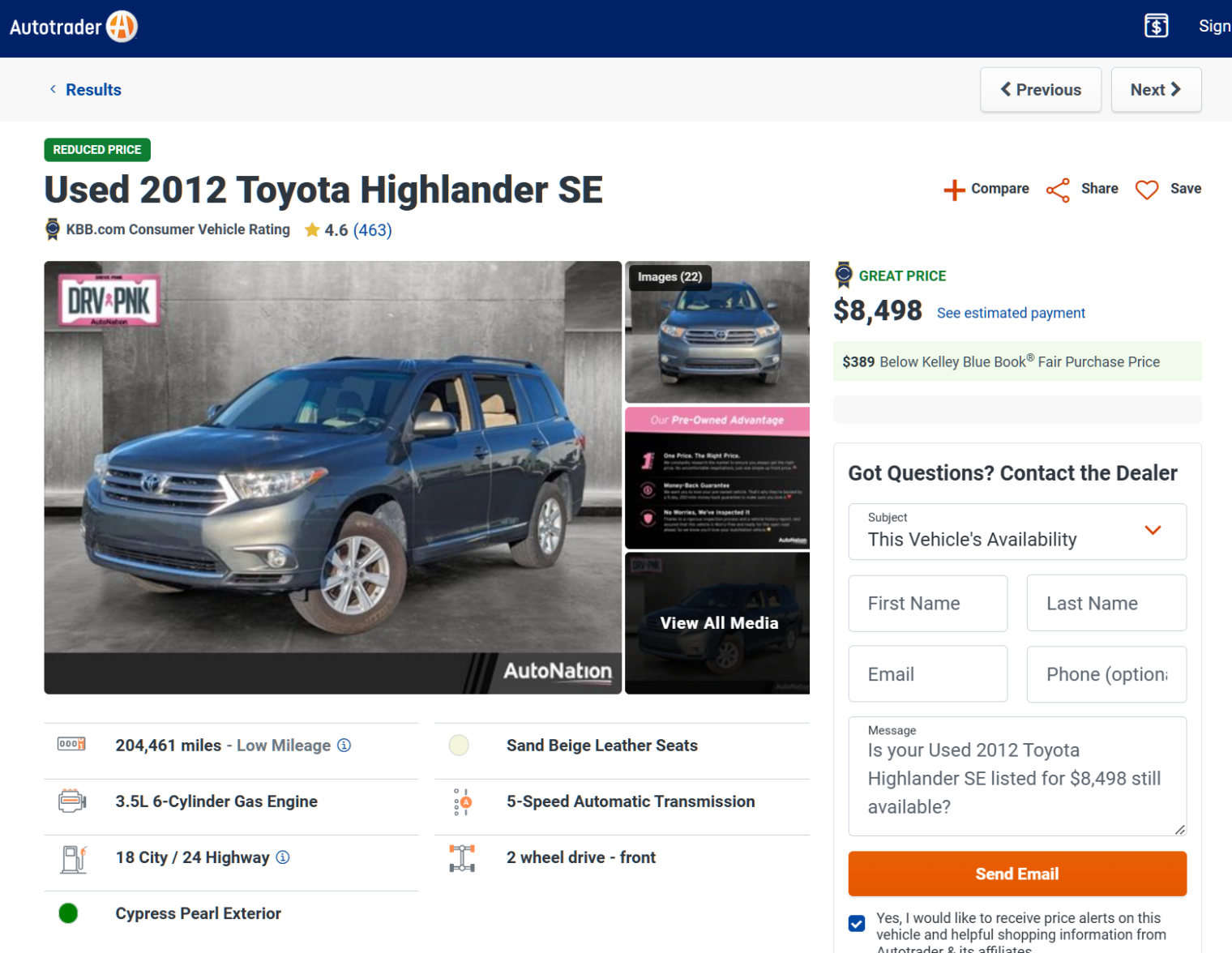I was chatting with a senior engineer at a Detroit automaker. “We design the car to last 10 years or 150,000 miles,” he said. He explained that component manufacturers try to torture-test the components so as to meet the same standard and then the entire car is given an accelerated aging beating on a test track, e.g., with a road so bumpy that the car needs to be driven by a robot to avoid employees developing back problems. What about other car companies? “As far as I know, all of us use the same standard.”
So… don’t pay real money for an old or high mileage used car! Here’s an example of a car that is about ready for the boneyard and that will cost over $15,000 including taxes and fees:
The price for this 2012 Toyota with 204,000+ miles seems insane, but it aligns with KBB estimates in our inflation-free completely-affordable-for-the-working-class economy:
“Low Mileage”?!?



At 250,000 miles in my most recent vehicles, trouble-free If you are patriotic and want made in America car that gets you from point A to point B without a fuss by Honda or Mazda. Honda has the most made in America parts content out of all automakers.
Carvana cuts off at 2009 for Civics. Wonder how many modern prices are based on algorithm recommendations like zestimates instead of prices being paid. More & more stuff is getting priced by an algorithm, just like elections.
Maybe from the Big 3 American automakers. I bought a 2004 4Runner Toyota in January of 2005 and kept it for 14.5 years, 315,000 miles. It was leaking some oil from the valve covers and timing cover but it has the best vehicle I’ve owned so far.
The 2025 4Runner has a new turbo-charged 4-cylinder engine (40% smaller), with a battery + electric motor + hybrid computer controller. Any bets whether this new new model last 300,000 miles too?
Anon, the short answer is yes. Most of the world does just fine with 4cyl + turbo.
Reminiscent of the light bulb cartel, that set the life of a bulb at 1,000 hours (down from 2,500 previously), and would fine manufacturers that made longer-lasting ones:
https://en.wikipedia.org/wiki/Phoebus_cartel
They call it planned obsolescence. I have asked other bears around the woods to give me examples of industries that do this, and they growled about smartphones, appliances, fashion, cars, and software.
There’s a couple of important variables to take into consideration:
1) Is the car well maintained, including regular oil changes?
2) Is the car garaged?
3) Is the car exposed to road salt?
4) Does the owner drive carefully, or slam through potholes?
5) Is the interior taken care of? For example, no smoking and not filthy.
These make a big difference in longevity.
If you want a car that lasts, get a Toyota.
Toyota Corrola. Timing chain (400,000 miles not timing belt (80,000 miles). The 2017 Corolla I have has a metal radiator (eternal life, amen). The Dodge Grand Voyager I inherited had a plastic one- average life 80-100K or 6-8 years.
I had a Toyota Corolla once. One of the cylinders failed at 150,000 miles. To be fair, Corolla could start up and drive with one cylinder shot down. Toyota dealer tried to repair but just wasted my $2.5K on it, it was 10 years ago. I searched and it appears that engine failure was common in Toyotas.
Since than I am sticking with Hondas for commute. Over decades, My Hondas routinely ran for around 300,000 miles, before being totaled or sold for scrap when small accident repair costed more then its book value. Scrap value was too greater then its book value.
For shorter distances and for less frequent use, for off-road, vacation travel and hauling loads I prefer GM pick-up trucks, which are trouble free up to 100K miles after fixing union assembly on corporate warranty at a good mechanic. Off-road they produce way less noise and debris then Jeeps and are also better on ice and in deep snow.
At first I was tightening GM pick-ups myself, but I did not have enough knowledge to tighten them up for good. After 100 K GM tracks are becoming head -aches, but my knowledgeable mechanic says that engine and frame can last forever, however it requires pro-active treatment for other components. Some people agree, I was berated for selling on the them before notifying one of my acquaintances, who apparently wanted it.
These design goals are not for the average car, they are for a large fraction of the fleet. So the average life must be higher than these so that only a small tail is below the 150,000 mile goal. If they will pay out warranty costs at 100,000 miles, they want zero failures before this point. The 150,000 goal comes with a statistical limit something like 90% or 95% of the cars will fail after this.
Peter: You are certainly correct that if the goal is 95% of cars trouble-free for 150,000 miles then most will also make it to 151,000 miles! But on the other hand, the manufacturer won’t sell anyone a warranty beyond 60,000 or 100,000 miles.
In one conversation, you reinforced my decision to only ever buy Japanese, as I have done for the last 19 years!
Having bought two cars in my lifetime, I can attest to this theory. Although 10 years ago, I would have said that it is 10 years or 100,000 miles.
For those building a database, here are my results:
*1997 Ford Taurus: 10 years, “Just over 100,000” miles when the repairs became too much
*2005 Lexus ES 330, (Bought used in 2006), I got 17 years and 160,000 miles. I could have still driven this, but the local mechanic here in Olney, MD seemed to think I needed $3,000 in repairs for a MD inspection sticker. To this day I think my significant other called him and put a similar “short squeeze” on me to buy a new car. All worked out, turns out at my age (54), I need the blind spot detection, parking sensors, auto stop, lane tracking assist. I can’t drive a car without those features now!
German comapanies like BMW design the car to last as long as the lease. That’s why many of the components in the engine are plastic, they are designed to save weight and last as long as the lease and no longer.